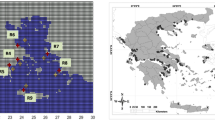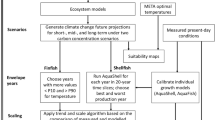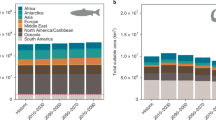Abstract
Hatcheries have long been used in an attempt to mitigate for declines in wild stocks of Pacific salmon (Oncorhynchus spp.), though the conservation benefit of hatcheries is a topic of ongoing debate. Irrespective of conservation benefits, a fundamental question is whether hatcheries will be able to function as they have in the past given anticipated future climate conditions. To begin to answer this question, we developed a deterministic modeling framework to evaluate how climate change may affect hatcheries that rear Pacific salmon. The framework considers the physiological tolerances for each species, incorporates a temperature-driven growth model, and uses two metrics commonly monitored by hatchery managers to determine the impacts of changes in water temperature and availability on hatchery rearing conditions. As a case study, we applied the model to the US Fish and Wildlife Service’s Winthrop National Fish Hatchery. We projected that hatchery environmental conditions remained within the general physiological tolerances for Chinook salmon in the 2040s (assuming A1B greenhouse gas emissions scenario), but that warmer water temperatures in summer accelerated juvenile salmon growth. Increased growth during summer coincided with periods when water availability should also be lower, thus increasing the likelihood of physiological stress in juvenile salmon. The identification of these climate sensitivities led to a consideration of potential mitigation strategies such as chilling water, altering rations, or modifying rearing cycles. The framework can be refined with new information, but in its present form, it provides a consistent, repeatable method to assess the vulnerability of hatcheries to predicted climate change.








Similar content being viewed by others
References
Anderson RO, Gutreuter SJ (1983) Length, weight, and associated structural indices. In: Nielson LA, Johnson DL (eds) Fisheries techniques. American Fisheries Society, Bethesda, MD, pp 283–300
Barnett T, Malone R, Pennell W, Stammer D, Semtner B, Washington W (2004) The effects of climate change on water resources in the West: introduction and overview. Clim Change 62:1–11
Barton BA (2002) Stress in fishes: a diversity of responses with particular reference to changes in circulating corticosteroids. Integr Comp Biol 42:517–525
Barton BA, Iwama GK (1991) Physiological changes in fish from stress in aquaculture with emphasis on the response and effects of corticosteroids. Annu Rev Fish Dis 1:3–26
Battin J, Wiley MW, Ruckelhaus MH, Palmer KN, Kolb E, Bartz KK, Imaki H (2007) Projected impacts of climate change on salmon habitat restoration. Proc Nat Acad Sci 104:6720–6725
Beechie T, Imaki H, Greene J, Wade A, Wu H, Pess G, Roni P, Kimball J, Stanford J, Kiffney P, Mantua N (2013) Restoring salmon habitat for a changing climate. River Res Appl 29:939–960
Benjamin JR, Connolly PJ, Romine JG, Perry RW (2013) Potential effects of changes in temperature and food resources on life history trajectories of juvenile Oncorhynchus mykiss. Trans Am Fish Soc 142:208–220
Berejikian BA, Larsen DA, Swanson P, Moore ME, Tatara CP, Gale WL, Pasley CR, Beckman BR (2012) Development of natural growth regimes for hatchery reared steelhead to reduce residualism, fitness loss, and negative ecological interactions. Environ Biol Fishes 94:29–44
Connor WP, Smith SG, Andersen T, Bradbury SM, Burum DC, Hockersmith EE, Schuck ML, Mende GW, Bugert RM (2004) Postrelease performance of hatchery yearling and subyearling fall Chinook salmon released into the Snake River. N Am J Fish Manag 24:545–560
Crozier LG, Hendry AP, Lawson PW, Quinn TP, Mantua NJ, Battin J, Shaw RG, Huey RB (2008a) Potential responses to climate change in organisms with complex life histories: evolution and plasticity in Pacific salmon. Evol Appl 1:252–270
Crozier LG, Zabel RW, Hamlet AF (2008b) Predicting differential effects of climate change at the population level with life-cycle models of spring Chinook salmon. Glob Change Biol 14:236–249
Dumas A, France J, Bureau DP (2007) Evidence of three growth stanzas in rainbow trout (Oncorhynchus mykiss) across life stages and adaptation of the thermal-unit growth coefficient. Aquaculture 267:139–146
Elliott JM (1981) Some aspects of thermal stress on freshwater teleosts. In: Pickering AD (ed) Stress and fish. Academic Press, New York, pp 209–245
Fabry VJ, Seibel BA, Feely RA, Orr JC (2008) Impacts of ocean acidification on marine fauna and ecosystem processes. ICES J Mar Sci 65:414–432
Ganguly AR, Steinhaeuser K, Erickson DJ III, Branstetter M, Parish ES, Singh N, Drake JB, Buja L (2009) Higher trends but larger uncertainty and geographic variability in 21st century temperature and heat waves. Proc Natl Acad Sci 106:15555–15559
Good C, Davidson J, Welsh C, Brazil B, Snekvik K, Summerfelt S (2009) The impact of water exchange rate on the health and performance of rainbow trout Oncorhynchus mykiss in water recirculation aquaculture systems. Aquaculture 294:80–85
Hamlet AF, Salathé EP, Carrasco P (2010) Statistical downscaling techniques for global climate model simulations of temperature and precipitation with application to water resources planning studies. Chapter 4 in Final Report for the Columbia Basin Climate Change Scenarios Project, Climate Impacts Group, Center for Science in the Earth System, Joint Institute for the Study of the Atmosphere and Ocean, University of Washington, Seattle
Hanson KC, Ostrand KG (2011) Potential effects of global climate change on National Fish Hatchery operations in the Pacific Northwest, USA. Aquac Environ Interact 1:175–186
Healey M (2011) The cumulative impacts of climate change on Fraser River sockeye salmon (Oncorhynchus nerka) and implications for management. Can J Fish Aquat Sci 68:718–737
Intergovernmental Panel on Climate Change (IPCC) (2007) Climate change 2007: Synthesis report. Intergovernmental Panel on Climate Change, Geneva, Switzerland
Isaak DJ, Wollrab S, Horan DL, Chandler G (2011) Climate change effects on stream and river temperatures across the Northwest U.S. from 1980–2009 and implications for salmonids fishes. Clim Chang 113:499–524
Iwama GK, Tautz AF (1981) A simple growth model for salmonids in hatcheries. Can J Fish Aquat Sci 38:649–656
Jobling M (2010) Are compensatory growth and catch-up growth two sides of the same coin? Aquac Int 18:501–510
Kaushal SS, Likens GE, Jaworksi NA, Pace ML, Sides AM, Seekell D, Belt KT, Secor DH, Wingate RL (2010) Rising stream and river temperatures in the United States. Front Ecol Environ 8:461–466
Larsen DA, Beckman BR, Cooper KA, Barrett D, Johnston M, Swanson P, Dickhoff WW (2004) Assessment of high rates of precocious male maturation in a spring Chinook salmon supplementation hatchery program. Trans Am Fish Soc 133:98–120
Larsen DA, Beckman BR, Strom CR, Parkins PJ, Cooper KA, Fast DE, Dickhoff WW (2006) Growth modulation alters the incidence of early male maturation and physiological development of hatchery reared spring Chinook salmon: a comparison with wild fish. Trans Am Fish Soc 135:1017–1032
Le Quéré C, Raupach MR, Canadell JG, Marland G, Bopp L, Ciais P, Conway TJ, Doney SC, Feely RA, Foster P, Friedlingstein P, Gurney K, Houghton RA, House JI, Huntingford C, Levy PE, Lomas MR, Majkut J, Metzl N, Ometto JP, Peters GP, Prentice IC, Randerson JT, Running SW, Sarmiento JL, Schuster U, Sitch S, Takahashi T, Viovy N, van der Werf GR, Woodward FI (2009) Trends in the sources and sinks of carbon dioxide. Nat Geosci 2:831–836
Leppi JC, DeLuca TH, Harrar SW, Running SW (2011) Impacts of climate change on August stream discharge in the Central-Rocky Mountains. Clim Chang 112:997–1014
Liang X, Lettenmaier DP, Wood EF, Burges SJ (1994) A simple hydrologically based model of land-surface water and energy fluxes for general-circulation models. J Geophys Res 99:14415–14428
Lichatowich HA, McIntyre JD (1987) Use of hatcheries in the management of Pacific anadromous salmonids. Am Fish Soc Symp 1:131–136
Manning MR, Edmonds J, Emori S, Grubler A, Hibbard K, Joos F, Kainuma M, Keeling RF, Kram T, Manning AC, Meinshausen M, Moss R, Nakicenovic N, Riahi K, Rose SK, Smith S, Swart R, van Vuuren DP (2010) Misrepresentation of the IPCC CO2 emission scenarios. Nat Geosci 3:376–377
Mantua N, Tohver I, Hamlet A (2010) Climate change impacts on streamflow extremes and summertime stream temperature and their possible consequences for freshwater salmon habitat in Washington State. Clim Chang 102:187–223
Marcos-López M, Gale P, Oidtmann BC, Peeler EJ (2010) Assessing the impact of climate change on disease emergence in freshwater fish in the United Kingdom. Transbound Emerg Dis 57:293–304
Martins EG, Hinch SG, Patterson DA, Hague MJ, Cooke SJ, Miller KM, Lapointe MF, English KK, Farrell AP (2011) Effects of river temperature and climate warming on stock-specific survival of adult migrating Fraser River sockeye salmon (Oncorhynchus nerka). Global Change Biol 17:99–114
Mayer T, Strachan S (2012) Winthrop National Fish Hatchery Water Resource Inventory and Assessment. Division of Engineering, Water Resources Branch, US Fish and Wildlife Service Region 1, Portland, OR
Meehl GA, Tebaldi C (2004) More intense, more frequent, and longer lasting heat waves in the 21st century. Science 305:994–997
Miles EL, Snover AK, Hamlet AF, Callahan B, Fluharty D (2000) Pacific Northwest regional assessment: the impacts of climate variability and climate change on the water resources of the Columbia River Basin. J Am Water Resour Assoc 36:399–420
Mitchell JFB, Lowe J, Wood RA, Vellinga M (2006) Extreme events due to human-induced climate change. Philos Trans R Soc Lond A 364:2117–2133
Mohseni O, Stefan HG, Erickson TR (1998) A nonlinear regression model for weekly stream temperatures. Water Resour Res 34:2685–2692
Moring W (1986) Stocking anadromous species to restore or enhance fisheries. In: Stroud RH (ed) Fish culture in fisheries management. American Fisheries Society, Bethesda, MD, pp 75–80
Nash JE, Sutcliffe JV (1970) River flow forecasting through conceptual models. J Hydrol 10:282–290
National Research Council (NRC) (1996) Upstream: salmon and society in the Pacific Northwest. Committee on Protection, and Management of Pacific Northwest Anadromous Salmonids. National Academies Press, Washington, D.C
Nehlsen W, Williams JE, Lichatowich JA (1991) Pacific salmon at the crossroads: stocks at risk from California, Oregon, Idaho, and Washington. Fisheries 16:4–21
Okamura B, Hartikainen H, Schmidt-Posthaus H, Wahli T (2011) Life cycle complexity, environmental change and the emerging status of salmonid proliferative kidney disease. Freshw Biol 56:735–753
Passolt G (2012) Predator susceptibility model of juvenile salmon survival. MS thesis, University of Washington, Seattle, WA
Payne JT, Wood AW, Hamlet AF, Palmer RN, Lettenmaier DP (2004) Mitigating the effects of climate change on the water resources of the Columbia River Basin. Clim Change 62:233–256
Piper RG, McElwain IB, Orme LE, McCraren JP, Fowler LG, Leonard JR (1982) Fish hatchery management. US Fish and Wildlife Service, Washington, D.C.
Ruesch AS, Torgersen CE, Lawler JJ, Olden JD, Peterson EE, Volk CJ, and Lawrence DJ (2012) Projected climate Induced Habitat Loss for Salmonids in the John Day River Network, Oregon, USA. Conservation Biology, 26:873–882.
Scheuerell MD, Williams JG (2005) Forecasting climate-induced changes in the survival of Snake River spring/summer Chinook salmon (Oncorhynchus tshawytscha). Fish Oceanogr 14:448–457
Scheuerell MD, Hilborn R, Ruckelshaus MH, Bartz KK, Lagueux KM, Haas AD, Rawson K (2006) The Shiraz model: a tool for incorporating anthropogenic effects and fish–habitat relationships in conservation planning. Can J Fish Aquat Sci 63:1596–1607
Strange JS (2010) Upper thermal limits to migration in auld Chinook salmon: evidence from the Klamath River Basin. Trans Am Fish Soc 139:1091–1108
United States vs. Oregon (2008) 2008–2017 United States vs. Oregon Management Agreement
US EPA (2012) National water program 2012 strategy: response to climate change. EPA-850-K-12-004, Office of Water, U.S. Environmental Protection Agency, Washington D.C.
USFWS (2005) Hatchery and Genetic Management Plan. Unpublished Report, Winthrop National Fish Hatchery, US Fish and Wildlife Service, Winthrop, WA
Waples RS (1999) Dispelling some myths about hatcheries. Fisheries 24:12–21
WDFW and ODFW (2002) Status report—Columbia River fish runs and fisheries, 1938–2000. Joint Columbia River Management Staff, Vancouver, WA/Clackamas, OR
Wedemeyer GA (ed) (2001) Fish hatchery management, 2nd edn. American Fisheries Society, Bethesda, MD
Wenger SJ, Isaak DJ, Luce CH, Neville HM, Fausch KD, Dunham JB, Dauwalter DC, Young MK, Elsner MM, Rieman BE, Hamlet AF, Williams JE (2011a) Flow regime, temperature, and biotic interactions drive differential declines of trout species under climate change. Proc Natl Acad Sci 108:14175–14180
Wenger SJ, Isaak DJ, Dunham JB, Fausch KD, Luce CH, Neville HM, Rieman BE, Young MK, Nagel DE, Horan DL, Chandler GL (2011b) Role of climate and invasive species in structuring trout distributions in the interior Columbia River Basin, USA. Can J Fish Aquat Sci 68:988–1008
Westerling AL, Hidalgo HG, Cayan DR, Swetnam TW (2006) Warming and earlier spring increases Western U.S. forest wildfire activity. Science 313:940–943
Wood AW, Lettenmaier DP, Palmer RN (1997) Assessing climate change implications for water resources planning. Clim Change 37:203–228
Acknowledgments
We thank Chris Pasley and the staff at WNFH for providing data and comments during the modeling process. The USFWS Pacific Region Climate Change Planning Team of Chris Pasley, Bill Gale, Patty Crandell and Don Campton provided general guidance on the scope and content of this project, and also contributed useful comments on this report. Ingrid Tohver and Nate Mantua (University of Washington, Climate Impacts Group) provided water temperature predictions for the Methow River basin. Tim Mayer (USFWS) provided valuable advice on how to consider surface–groundwater interactions in our analyses. Bill Brignon (USFWS), Joy Evered (USFWS), Doug Olsen (USFWS), David Patte (USFWS), Bruce Marcot (US Forest Service), Keeley Murdoch (Yakama Nation Fisheries Program), Tim Roth (USFWS), Brad Thompson (USFWS), and Nate Wiese (USFWS) raised important issues and participated in helpful discussions to inform the modeling approach. The findings and conclusions in this report are those of the authors and do not necessarily represent the views of the U. S. Fish and Wildlife Service.
Author information
Authors and Affiliations
Corresponding author
Electronic supplementary material
Below is the link to the electronic supplementary material.
Rights and permissions
About this article
Cite this article
Hanson, K.C., Peterson, D.P. Modeling the Potential Impacts of Climate Change on Pacific Salmon Culture Programs: An Example at Winthrop National Fish Hatchery. Environmental Management 54, 433–448 (2014). https://doi.org/10.1007/s00267-014-0302-2
Received:
Accepted:
Published:
Issue Date:
DOI: https://doi.org/10.1007/s00267-014-0302-2




